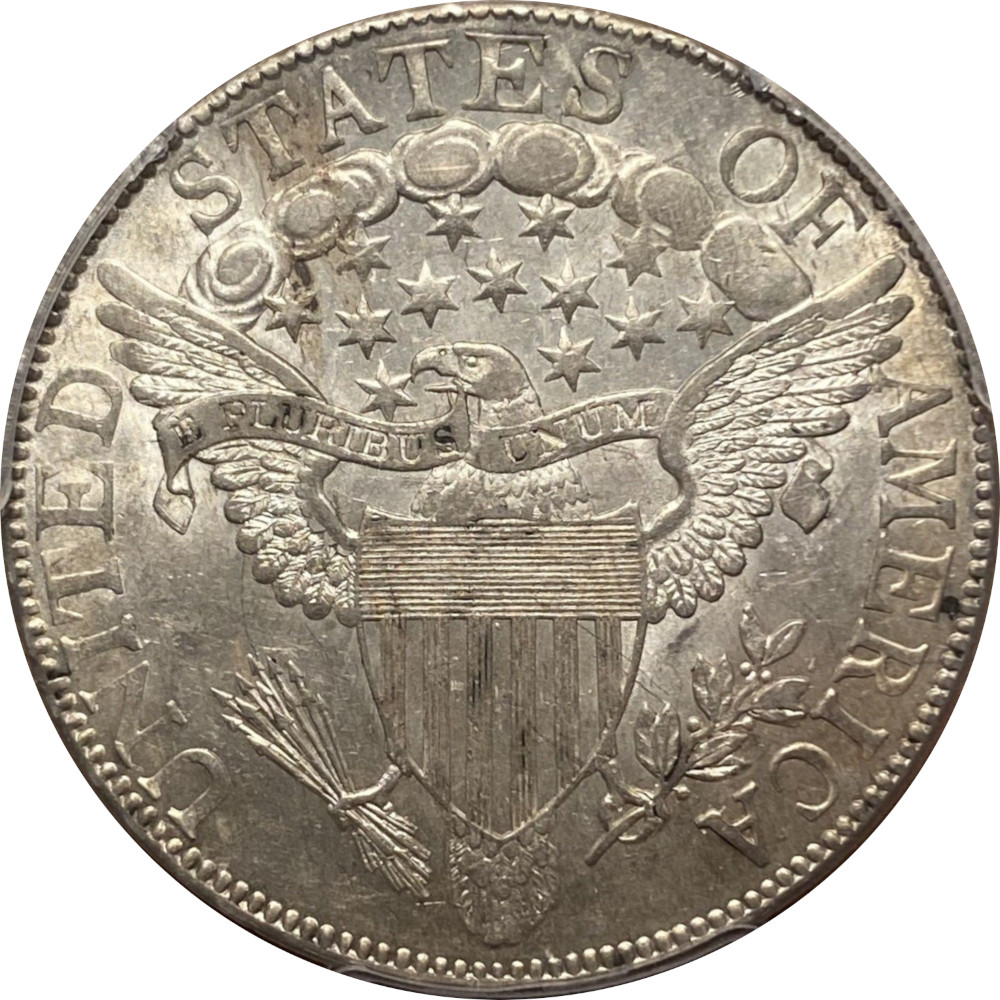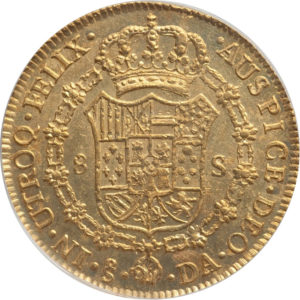1838-D $5 Classic Head Half Eagle 1st Dahlonega Mint Coin, HM-1,Winter 1A, R3, PCGS AU55.
The first U.S. gold rush started on 1799 when a 12-year old boy named Conrad Reed found a 17lb (7.7kg) gold nugget while playing in Meadow Creek on his family’s farm in Carrabus County, North Carolina. The nugget was used as a doorstop in the family home until 1802 when Conrad’s father showed the rock to a jeweler and sold it for $3.50 (about $76.91 in 2024 and 1 week’s pay for a farm laborer at the time). The large nugget’s value was around $3,600 in 1802. In 1803, John Reed, Conrad’s father, with a few associates in a gold searching venture found a nugget weighing 28lbs (13kg). And thus the first gold rush in our young Nation began in the Carolinas.
Back in 1540, the Cherokee in Northern Georgia had told Spanish conquistador Hernando de Soto how small quantities of gold were mined, melted and refined by their tribe. In 1828, it has been told that several people had found gold nuggets along several creeks. One of these places was Ward’s Creek in Dahlonega, Georgia. By 1829, the second major gold rush in our Nation was taking place. By 1830, the Philadelphia Mint received $212,000 in gold for coining from Georgia.
The Georgia gold rush attracted 6,000-10,000 miners who quickly began encroaching on land that belonged to the Cherokee by U.S. Treaty, and their sovereignty was ignored in the search for gold. Tensions between the Cherokee and neighboring states, including Georgia, led to the forced removal and relocation of Native Americans better known as the Trail of Tears. President Jackson authorized the Indian Removal Act in 1830 which among other things allowed the takeover of mining areas and the removal of 60,000 people from the “Five Civilized Tribes.” 2,500-6,000 died in the Trail of Tears and Southern slaves were made to work the gold mines.
In 1835, the Coinage Act of 1835 was signed into law by President Andrew Jackson. The law called for the establishment of new branch mints in Charlotte, NC, Dahlonega, GA, and New Orleans, LA. Jackson lobbied hard for the establishment of the NOLA Mint.
The Dahlonega Mint (pictured above in 1877) opened in 1838 as did the Charlotte and New Orleans Mints.
In 1838, the Dahlonega Mint reported a mintage of 20,583 half eagles, the only denomination minted that year. The quarter eagle was first minted in 1839, the gold dollar began production in 1849 and the gold $3 was minted only in 1854. No eagles, double eagles, copper nor silver coins were produced at the Dahlonega Mint.
Both the Dahlonega Mint and the Charlotte Mint operated from 1838 to 1861 failing to survive through the Civil War. In those 24 years, the Dahlonega Mint coined $6.1 million in gold and the Charlotte Mint managed to coin only $5 million in gold, a tiny fraction of the production that came out of the San Francisco and New Orleans Mints. In just the partial, initial year of production at the San Francisco Mint in 1954, the facility minted $4 million of gold into coins. By the time of the earthquake in 1906, the SF Mint held $300 million in gold (7.63 billion in 2023) or a third of all U.S. gold reserves. The New Orleans Mint coined $307 million in gold and silver coins between 1838 and 1909.
It was the first and only coin minted at the Dahlonega Mint in 1838. It is also a one year type as the Classic Head half eagle was only minted in 1838. From 1839 to 1908, the half eagle design changed to the Liberty Head design. The first quarter eagles were minted at Dahlonega in 1839, and were also in the classic head design, just for the first year of that denomination. The quarter eagle changed to the Liberty Head design in 1840.
All 20,583 half eagles coined in Dahlonega in 1838 were struck by a single die pair, HM-1 or Winter-1A with a rarity rating of R3. Most of these were distributed regionally and saw extensive circulation. 1838-D half eagles in Fine and Very Fine grade are not unusual. Sylvia Gailey Head and Elizabeth W. Etheridge’s work “The Neighborhood Mint: Dahlonega in the Age of Jackson” reports that the first coins struck at Dahlonega were half eagles. The first press run of 80 coins was struck on April 17, 1838, as recorded in a letter from Mint Superintendent Dr. Joseph J. Singleton to Philadelphia Mint Director Robert M. Patterson on May 1, 1838. Lacking good leadership and technical skills, the Dahlonega Mint got off to a rough start. Important equipment took ages to reach north Georgia from Philadelphia, or it never arrived at all. Quarter eagles were not struck until 1839, and new half eagle dies for 1839 were not received until April of that year. Though silver coinage was authorized by Congress to be struck in Dahlonega in 1840, the facility struck nothing but gold coins until its closure. Taken over by the Confederacy in 1861, the mint structure was left abandoned after the Civil War. In 1871, the building was given to the North Georgia Agricultural College. After the mint burned down in 1878, another structure was constructed on the foundation and now serves as an administration building for the University of North Georgia.
Doug Winter writes for PCGS Coinfacts: The 1838-D half eagle is a very desirable issue. It is the first coin of this denomination struck at the Dahlonega Mint and the only Classic Head half eagle produced at this facility. It is less rare than one might believe but its popularity makes it one of the most highly valued Dahlonega half eagles.
The 1838-D is one of the more available Dahlonega half eagles but its status as a one year type coin and as a first year of issue makes it extremely popular. It is fairly easy to locate in Very Fine and Extremely Fine and lower quality About Uncirculated pieces are available. It becomes very scarce in the higher About Uncirculated grades and extremely rare in full Mint State.
STRIKE: The 1838-D is the best struck branch mint half eagle of this design. The obverse is usually well struck with all of the hair detail bold and defined. Some of the curls on the top of Liberty’s head appear weak; this is due to incomplete definition in the design. The stars are mostly sharp while the denticles are clear. The reverse is also well struck. Unlike the 1838-C half eagle (which has weak wings and incomplete details on the eagle’s right leg), the 1838-D generally shows fully defined feathers on the eagle and legs.
SURFACES: Many are very heavily abraded with marks in the field which enter deep into the planchet. In fact, it is hard to find an 1838-D half eagle which is not seriously marked. Subject coin seller remarks include: Doug Winter reports that this date almost always comes heavily abraded, yet here we have the exception with uncommonly well-preserved surfaces and sharp remaining detail. Lovely lemon-gold coloration dominates with plenty of bright luster remaining. Me: Can’t wait to examine this coin in hand. All known examples show a number of mint-made characteristics which serve as hallmarks of authenticity. There are two small die lumps in the ear of Liberty and die scratches on the throat and through the word LIBERTY. There are frequently a series of small clashmarks at the throat [Me: This can be seen clearly in the subject coin] and in the vertical lines of the shield.
LUSTER: Higher grade 1838-D half eagles have frosty luster. The quality of luster is very good in comparison to the 1838-C half eagle.
COLORATION: Original, uncleaned examples can show exceptionally nice coloration. Some have lovely orange-gold hues with coppery overtones while others show medium to deep green-gold shading. There are not many remaining which have a majority of their original coloration intact.
EYE APPEAL: Most 1838-D half eagles have below average eye appeal due to the fact that they are heavily worn, cleaned and/or significantly abraded. But when this date comes nice, it can be among the most pleasing issues in the entire Classic Head half eagle series. There are approximately six to eight exceptionally nice 1838-D half eagles in existence with great color, nearly full luster, relatively clean surfaces and sharp, even strike.
PERSONAL OBSERVATIONS: A remarkable group of 183w8-D half eagles was sold in the Heritage 1999 FUN auction as part of the North Georgia collection. The owner of the collection loved the design and history of this date and he acquired ten different specimens. These ranged in grade from Extremely Fine-45 to Mint State-62 and brought between $4,600 and $40,250. My personal favorite was Lot 7672. It was graded About Uncirculated-58 by PCGS and was notable for its magnificent multi-hued coloration. It brought $21,850, a record price for an About Uncirculated 1838-D half eagle.
DIE VARIETIES: One die variety is known.
Variety 1-A: The mintmark is located on the obverse; the only issue from this mint on which it is placed there. The mintmark is over the 3 in the date with the upright of the D over the ball of the 3. All of the numerals except for the second 8 are doubled at the base and the 8’s have the distinctive style referred to as “fancy 8’s”. On the reverse, the tip of the feather is centered over the 5. The D in the value is centered between the branch stem and the denticles. The second A in AMERICA is centered between the C and the arrowhead. The reeding is wide.
David Akers also in PCGS Coinfacts: The 1838-D is the third rarest date of this type after the 1834 Crosslet 4 and 1838-C. It is known in a wide range of grades but VF and EF are the grades one is most likely to encounter. I have seen only a few that by strict grading standards could be called uncirculated (the finest was Pine Tree 6/75) and not many more that were legitimately AU.




















